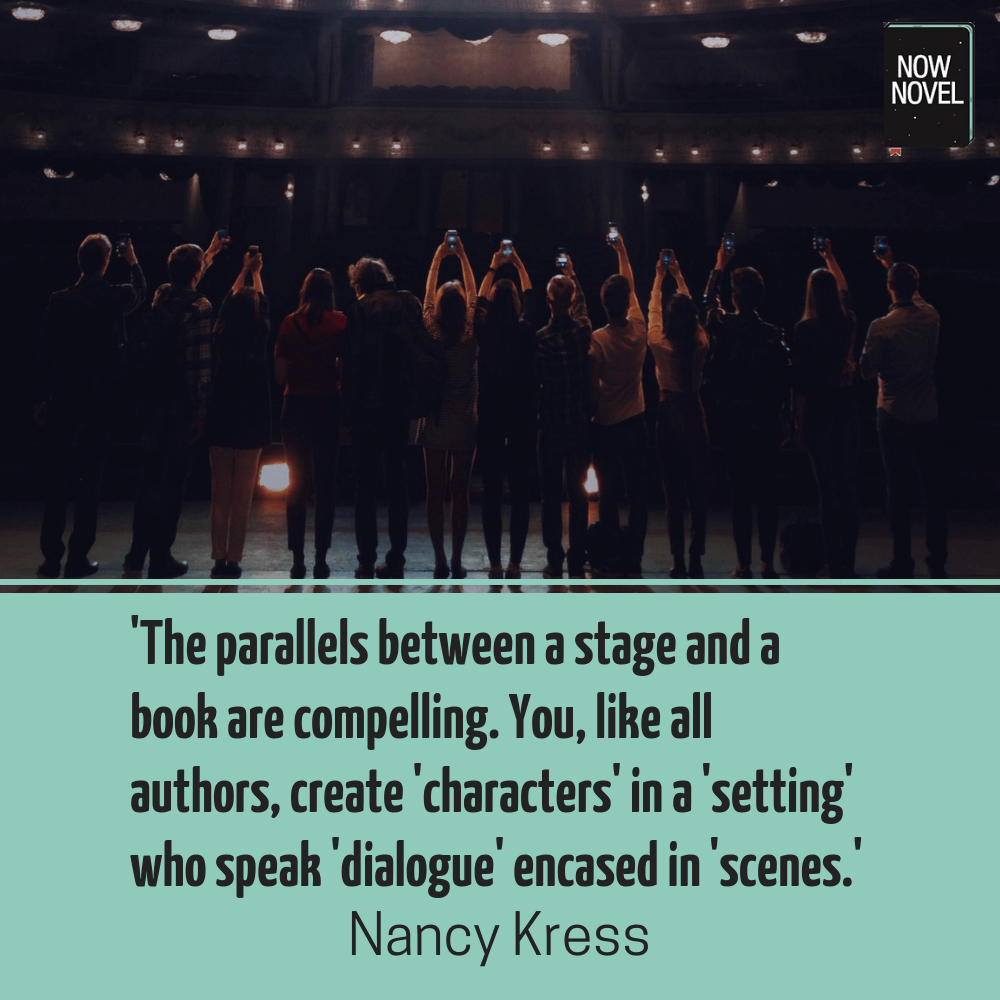Writing conversations that don’t involve setting is like writing action scenes that don’t involve movement. Great dialogue has more than disembodied voices. It anchors us in a place, in the context that occasions characters’ interaction. Read tips for creating realistic dialogue by involving your setting:
1. Include details about nearby structures and objects
What does a conversation beneath a neon light look like versus a conversation in a sunny, flower-filled field? Showing how characters look mid-dialogue is one way to write conversations that feel real. When all we have is the flow of characters’ words to anchor us, an exchange can feel without place.
An example of showing how setting affects characters’ appearances in dialogue
Barbara Kingsolver’s debut novel The Bean Trees tells the story of plucky rural Kentucky native, Taylor Greer. Determine to escape her rural life and what seems the only option (having babies), Taylor travels west. On her road trip, a woman abandons a baby with her outside a bar in Oklahoma, saying it is her dead sister’s child, and asking Taylor to take care of her.
Kingsolver weaves the setting – a neon-lit rest-stop – into her dialogue masterfully:
“Take this baby,” she said.
[…]
“Where do you want me to take it?”
She looked back at the bar, and then looked at me. “Just take it.”
I waited a minute, thinking that soon my mind would clear and I would understand what she was saying. It didn’t. The child had the exact same round eyes. All four of those eyes were hanging there in the darkness, hanging on me, waiting. The Budweiser sign blinked on and off, on and off, throwing a faint light that made the whites of their eyes look orange.’ (p. 17)
Notice how Kingsolver:
- Includes detail about surrounding structures in relation to her characters: The woman looks back to the bar
- Uses time of day to add tone and mood to the conversation: A bleak, sad quality creeps in when Kingsolver describes the woman and child’s eyes ‘hanging there in the darkness’
- Uses other setting details that shape appearances: The Budweiser sign blinking on and off alters the whites of woman and child’s eyes. This small, vivid detail makes the scene lifelike
[Need help writing conversations that make an impact? Join How to Write Dialogue, our 4-week course.]
2. Create tone in dialogue via interactions with setting
When writing conversations between characters, think about objects in the scene as though they are props on a stage. How could they add detail, colour, humour or interest to the scene?
Think of objects that create obstacles between characters, too. How does a locked door stuffed with a towel muffle the sound of voices?
Example of characters interacting with setting in dialogue
Zadie Smith’s novel White Teeth opens with the character Archie Jones deciding to take his life in his car while parked outside a Halaal butchery. Hearing of what’s going on outside his business, the butchery’s owner intervenes:
‘No one gases himself on my property,’ Mo snapped as he marched downstairs. ‘We are not licensed.’
Once in the street, Mo advanced upon Archie’s car, pulled out the towels that were sealing the gap in the driver’s window, and pushed it down five inches with brute, bullish force.
‘Do you hear that mister? We’re not licensed for suicides around here. This place halal. Kosher, understand? If you’re going to die round here, my friend, I’m afraid you’ve got to be thoroughly bled first.’ (p. 7)
Here, Smith includes Mo pulling out the towels sealing Archie’s car. The force of this gesture establishes the cross tone of the dialogue, because it shows Mo’s impatience.
Think of how characters’ interaction with setting in your dialogue may:
- Create the tone of the conversation: How do emotions in characters’ mid-dialogue (or pre- or post-dialogue) actions affect the tone of their spoken words?
- Change the physical setup of the scene: We go from Archie being isolated in his car to Mo’s cross (and darkly comical) intrusion

3. Develop background imagery throughout dialogue
A good tactic for writing conversations that feel real and anchored in a background sense of place is to develop imagery throughout the exchange.
For example, a character might sit on a chair when everyone present hears a loud ‘crack!’
Throughout the ensuing conversation, you could show them shift their weight every now and then, until the chair collapses. Weaving the ‘set’ of your story into conversation like this adds colour and character. An incident like the chair drama adds extra suspense and tension because we don’t know what consequences await.
Example of extending background imagery in dialogue
In her novel The God of Small Things, Arundhati Roy writes the following scene. The main character’s aunt, Baby Kochamma, is rubbing a cucumber at the start of a conversation with her grand-niece Rahel whom she hasn’t seen in years. Roy develops her imagery, keeping a unified, realistic sense of scene:
In the old house on the hill, Baby Kochamma sat at the dining table rubbing the thick, frothy bitterness out of an elderly cucumber. […] She worked on the cucumber with an air of barely concealed triumph. She was delighted that Estha had not spoken to Rahel. […]
‘I told you, didn’t I?’ she said to Rahel. ‘What did you expect?’ Special treatment? He’s lost his mind, I’m telling you! He doesn’t recognize people any more! What did you think?’ (p. 21)
Further on, when Rahel stays silent, Baby asks another question and we see the cucumber’s return:
The silence sat between grand-niece and baby grand aunt like a third person. A stranger. Swollen. Noxious. Baby Kochamma reminded herself to lock her bedroom door at night. She tried to think of something to say.
‘How d’you like my bob?’
With her cucumber hand she touched her new haircut.’ (p. 21)
By returning to the image of the cucumber the aunt has been rubbing, Roy maintains a sense of where we are – in the aunt’s kitchen. We remember background activities. They add character and continuity. A simple, small detail like a ‘cucumber hand’ masterfully keeps us in the scene, creating more realistic conversation.

4. Include aspects of time in your dialogue
Time is also an important element of setting. Setting is not only ‘where’ characters are but ‘when’ they are, too. Writing conversations that reflect the time aspect of setting means:
- Including time of day or seasonal details that affect how characters speak: For example, teens at a sleepover who’re awake past midnight might whisper so as not to wake others. A character’s teeth might chatter while talking to a friend as they walk a snowy sidewalk
- Including details that suggest time period or era: For example, in a historical novel set in the 1500s, there are some archaic words you could use, while avoiding modern words (such as ‘bromance’) that ruin the ‘period’ effect
Example of using time setting in dialogue
In the first section of David Mitchell’s novel Cloud Atlas, a sailor in the Caribbean, Adam Ewing, comes across a ship doctor who is collecting teeth on the beach. The doctor tells Ewing:
‘Teeth, sir, are the enamelled grails of the quest in hand. In days gone by this Arcadian strand was a cannibals’ banqueting hall, yes, where the strong engorged themselves on the weak.’ (p. 3)
The doctor proceeds to tell Ewing of his plans to sell his finds for false teeth for the wealthy back home:
‘Mr Ewing, are you acquainted with Marchioness Grace of Mayfair? No? The better for you, for she is a corpse in petticoats. Five years have passed since this harridan besmirched my name, yes, with imputations that resulted in my being blackballed from Society.’ (pp. 3-4)
After Ewing expresses consolation for the doctor’s experience, the man continues to reveal his elaborate plan for revenge:
‘I thank you, sir, I thank you, but these ivories,’ he shook his ‘kerchief, ‘are my angels of redemption. […] Permit me to elucidate. The Marchioness wears dental-fixtures fashioned by the aforementioned doctor. Next yuletide, just as that scented She-Donkey is addressing her Ambassadors’ Ball, I, Henry Goose, yes, I shall arise & declare to one & all that our hostess masticates with cannibals’ gnashers!’
Mitchell’s dialogue clearly conveys the sense of an earlier time, adding an element of historical realism. The frequent ‘gentlemanly’ and archaic use of the word ‘sir’ contributes to the effect. So do the many long, complex words (such as ‘besmirched’ meaning ‘to ruin’) that are not commonly used in modern conversation.
The example is a masterclass in writing conversations that seem to belong to a different time and place.
Join Now Novel and get constructive feedback on your dialogue from our community.

